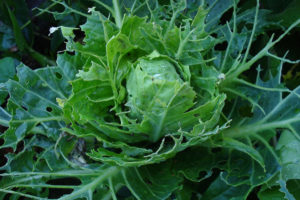
Hello! No wonder they say that people learn from mistakes. My main mistake last year was that I did not pay enough attention to the safety of cabbage.
As a result, caterpillars and cruciferous fleas almost completely destroyed my crop.
This year I was already fully armed. Proper processing allowed to avoid rampant pests. Want to learn how to handle cabbage from pests with folk remedies? What are the most reliable methods? Now I will sign everything in detail in the article below.
The content of the article:
Processing cabbage from pests with vinegar
Gardeners even with little experience know that protecting cabbage from pest invasion is not an easy task. And very often, in the fight against cabbage pests, good old folk remedies turn out to be much more effective than the advertised modern insecticides.
One of the folk remedies - processing cabbage from pests with vinegar will be discussed today.
From the flea
Cruciferous flea is not in vain awarded the title of the most dangerous pest of cabbage and other plants of the cruciferous family. This small jumping insect, hardly visible to the naked eye, can completely destroy even the strongest and most well-groomed cabbage seedlings in the shortest possible time.
At the same time, adult fleas that feed on leaves and its larvae that feed on roots cause harm to plants. Under favorable conditions, it multiplies at lightning speed, in a matter of days affecting the entire cabbage bed.
The recipe for treating cabbage with flea vinegar is as follows: in 10 liters of warm water, it is necessary to dissolve 1 cup of nine percent vinegar and process the cabbage. It is best to spray cabbage on a clear warm day, and in most cases, only one treatment is enough to successfully achieve the result.
You can also use vinegar essence, dissolving it in a proportion of 2 tablespoons per 10 liters of water and thoroughly spilling cabbage from a watering can with this solution.
From the caterpillars
Caterpillars of the butterfly cabbage or cabbage whitewater also cause irreparable harm to the cabbage. They not only eat holes of different sizes in its leaves, but also leave on them discharge that clogs the pores on the sheet and has toxic properties.
The recipe for treating cabbage with vinegar from caterpillars is as follows: 1 tablespoon of vinegar essence should be dissolved in 10 liters of warm water and sprinkled with cabbage in warm, clear weather.
Protection of cabbage from pests
Protection of cabbage from pests is one of the most important elements of agricultural technology of this culture. Simple folk remedies will help get rid of uninvited guests.
From cruciferous flea
Cruciferous fleas are small bugs that damage leaves by gnawing flesh in them in the form of small rounded spots along the edge of the leaf. Damage seedlings, seedlings, testes after planting.
A good and yet environmentally friendly remedy for cabbage pests is pollination with ash sifted through a sieve.
In the aisles of cabbage, plant a leaf or head of lettuce - this is prevention from the appearance of a cruciferous flea.
From gray aphids
Gray aphids are small, light insects that feed on cabbage juice, almost merging in color with cabbage leaves. The outer leaves become pinkish, thinner and curl.
Protection:
- with a foam sponge, coat the cabbage with a foam of laundry soap;
- dilute half a liter of milk and 10 drops of iodine in a bucket of water, spray cabbage with this solution;
- spray with a decoction or infusion of potato or tomato tops;
- ash-soap solution (see below);
- pungent herbal infusions: infusions of garlic, onions, tobacco.
Eco-friendly measures against cabbage whitewash. In July-August, large, yellow-green with black dots and yellow strips of cabbage white caterpillars appear on cabbage plants, which eat leaves, starting from the edges, leaving large veins.
Inspect the underside of the leaves daily, remove the egg masonry with a wet swab.
It is noticed that the butterfly of cabbage white does not lay eggs on a dirty rough leaf or on a cabbage with a strange smell, so if you spray it with an ash-soap solution, weed infusion, garlic or onion infusion, the butterfly will fly around your cabbage side.
Burdock infusion: burdock (you can use all parts of the plant) cut and fill it with a container for 2/3 of the volume, add water to the top. Insist a week. Then dilute 1 liter of infusion in 10 liters of water and spray cabbage. Processing is carried out after 1-2 weeks, depending on the appearance of butterflies.
Against aphids and caterpillars
Make an infusion: pour 1 glass of ash with 10 liters of cold water, mix and leave until morning. Stir in the morning and strain. Spray the plants early in the morning, about 6 hours, before the beginning of the summer of butterflies, as often as possible, capturing the lower part of the leaves.
From the cabbage moth
Caterpillars of cabbage moth damage the cabbage in June-July, gnawing the flesh in the leaves, where small windows form, penetrate the young head of cabbage, spoil it.
Helps tame the pest dusting with wood ash.
From cabbage scoops
The caterpillars in the cabbage scoops of a young age are green, then brown-brown with a back-slash pattern on the back. They dig through large through holes in the head of cabbage and spoil it with excrement. The measures against these caterpillars are the same as against the cabbage moth.
In a personal garden you can collect and destroy them without using poisons.
From the cabbage fly
The cabbage fly begins to lay eggs directly on the soil in the second half of May, bringing the most damage to seedlings planted in open ground. Larva gnaws at the base of the stem and root, destroying the plant. Especially significant damage is done in wet weather (in a dry year, the egg dries out on the soil or the larva dies).
To combat this pest, it is recommended to scrub the soil from the cabbage, and pour the plant itself with salt water (1 glass of salt per 10 liters of water).
Sprinkle the soil around the stem with wood ash.
Since the end of May, cabbage is also required to be protected from slugs and snails, which at this time emerge from last year's eggs and grow rapidly, devouring a huge amount of green mass of cabbage.
A solution of yeast mash, which, in addition, when growing cabbage, acts as root and non-root top dressing, eliminates many pests.
A universal pest control agent - wood ash - it is used for pollination of cabbage, as well as for spraying in the form of infusions from almost all pests.
And the most reliable and environmentally friendly means of protecting cabbage from pests is to close cabbage beds with non-woven material, carefully locking all the cracks.
Pests of cabbage and ways to deal with them
Cabbage is a wonderful vegetable, which even provides us with vitamin C. In winter, pests of cabbage very often lead to the death of most of the crop. To prevent this from happening, preventive pest control measures should be applied in a timely manner.
Below we will consider which cabbage pests pose the greatest danger and how to process cabbage from pests.
Cruciferous flea, is most dangerous for young plants, because it gnaws grooves in the delicate leaves, which then dry.
Add one tablespoon of any liquid soap to the resulting solution. Sprinkle the cabbage with a good wetting of the leaves. Pollination of young plants with a mixture of tobacco dust, cannon lime and ash also helps a lot.
Cabbage fly the flight of which begins in mid-May and lasts until the end of June, lays eggs near the stem or most often on the stem, from which cabbage fly larvae appear literally in a week. They eat the roots of the plant, gnaw through the passages in them and this leads to the death of the plant.
Folk remedy: pollinate the soil around the plant with a mixture: from 100 gr. wood ash and 100 gr. tobacco dust, add a teaspoon of any ground pepper and mix everything. After pollination with this mixture, it is good to loosen the soil to a depth of 3 cm.
Folk remedy: 1 liter of wood ash and add 2 tbsp. tablespoons of ordinary salt, ground pepper, and mustard powder. Mix the whole mixture.
Aphid - finely sucking insect. During the breeding season, this pest eats the juice of young leaves. A plant affected by aphids stops developing. The leaves curl into a dome shape. This aphid population grows rapidly in warm weather.
Folk remedy: add a glass of wood ash to 10 liters of water, a glass of tobacco dust and 1 tablespoon of mustard powder and liquid soap. The present day and strain. Spray the underside of the leaf and at the site of the largest accumulation of aphids.
Cabbage White - butterfly with small black spots on the wings. During the summer, she lays her eggs on the underside of the cabbage leaves, from which caterpillars subsequently appear. They quickly eat cabbage leaves.
Another pest nocturnal butterfly is a cabbage scoop. She lays her eggs on the leaves on the underside and the green larvae emerging from them eat through the leaves through, leaving a dark green discharge.
Folk remedy: prepare a solution of wood ash, for this, take about 2 glasses of ash and a tablespoon of any liquid soap. Spray the leaves of the plant. Once, when you see which pests of cabbage are threatening your crop, you will learn in time and take correct measures
Above, we examined which pests of cabbage most often affect plants and folk remedies to combat them. Next, we will consider how to process cabbage from pests in addition to simple folk methods.
There are three methods for controlling cabbage pests:
- folk method discussed above;
- mechanical - the most time-consuming, used with a small number of pests, and carried out manually. Pests (except cruciferous fleas) must be collected manually after 2-3 days. The advantage of this method is that pesticides are not used and beneficial insects are kept in the garden.
- using modern insecticides. They are safe for health if you follow all the recommendations indicated on the packaging of the drugs.
Processing cabbage from pests. How to handle cabbage from pests, you decide. If you decide to apply, you should remember some rules for processing plants.
Carefully read the instructions for use. Here too large doses as well as small ones should be avoided. Spray the leaves, carefully coating the solution with leaves on the upper and lower sides. You may need to repeat the processing.
Cabbage pests and pesticides
Tasty mother cabbage. Not capricious in growing. Feed and treat. Therefore, not only people and animals love her, but also pests. A lot of them. The sucking and gnawing representatives of the fauna are ready to be saturated with juice and pulp of cabbage from the first days of emergence of this culture.
Is it possible to get an environmentally friendly crop of products at home? Indeed, beautiful heads of cabbage in the markets and on official sale are at least 15-20 treatments for the growing season of a crop that are far from harmless to health with preparations.
Protection methods
Ways to protect cabbage from pests can be divided into 3 groups:
- traditional chemicals
- new biological
- folk.
All types of protection with the correct and timely conduct of agricultural activities ensure success.
Folk is the method of our grandmothers. Not always successful, overgrown with legends of supposedly instant destruction of pests with decoctions of herbs that are not always safe for humans (decoctions of hemlock, feverfew, aconite, etc.).
For protection to be successful, it is necessary to know the most vulnerable periods in the development cycle of crop pests, their nutrition methods, which will help to choose the appropriate drugs.
It is not advisable to poison each pest separately, therefore it is better to treat the culture with tank mixtures, which include several preparations, and destroy several types of individuals that are similar in type of nutrition in a certain period with one step.
In the autumn-winter, freer from gardening time, in the garden diary, you can make a table of plant treatments with the following columns:
- Months of hatching of larvae and caterpillars (combine them into groups according to the method of feeding),
- choose drugs for sucking and gnawing pests,
- indicate the waiting time (action) of drugs,
- select combinations of preparations for tank mixtures in order to destroy several pests with one treatment, including drugs designed for only one type of pest.
A table, schedule or list of works will help in the summer season reduce the preparatory work for protective measures.
The main sucking cabbage pests
Aphid. The main sucking pests include aphids, settling on the underside of young leaves of a curling head of cabbage. In spring, aphids migrate from the surrounding weeds, most of which are growing nearby cruciferous, to young cabbage plants.
The aphids in June are the most numerous - the time of hatching of live larvae by female settlers and in August, when female stripes appear. They lay wintering eggs. Anti-aphid treatments are required during these periods.
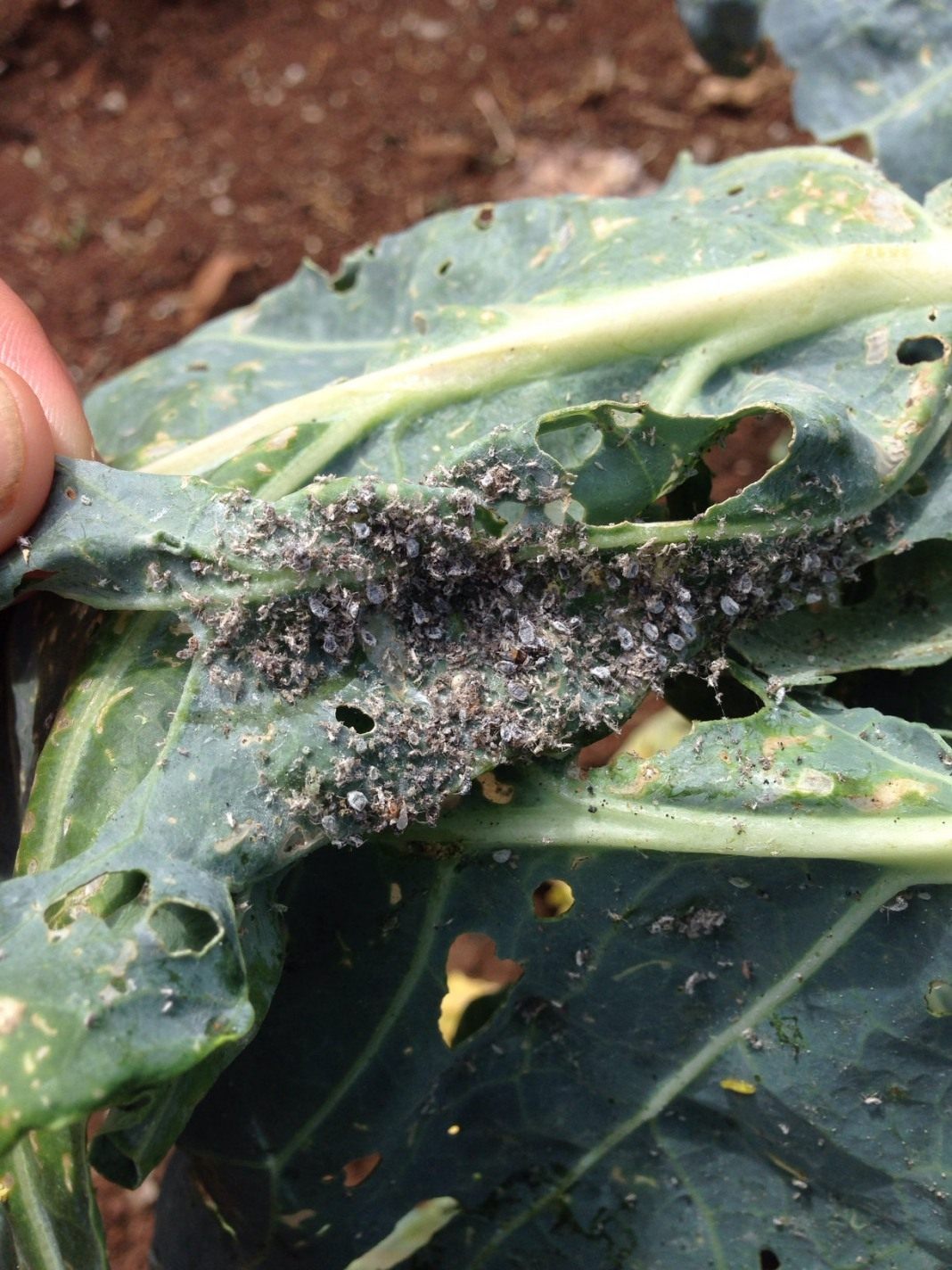
Thrips. Not the pest that is large in growth, but that which is insatiable. This is what people say about thrips. Unnoticed with the naked eye, adults suck out the juice, leaving abundant black spots of excrement on the mutilated leaves.
Under natural conditions, thrips can winter in the form of all stages of development and with the onset of warm, dry weather, they begin active movement and settlement of plants. For more effective destruction of the pest, simultaneous treatment of dry patches of soil and plants is necessary.
Contaminated soil is treated from early spring to late autumn in 2-3 weeks.
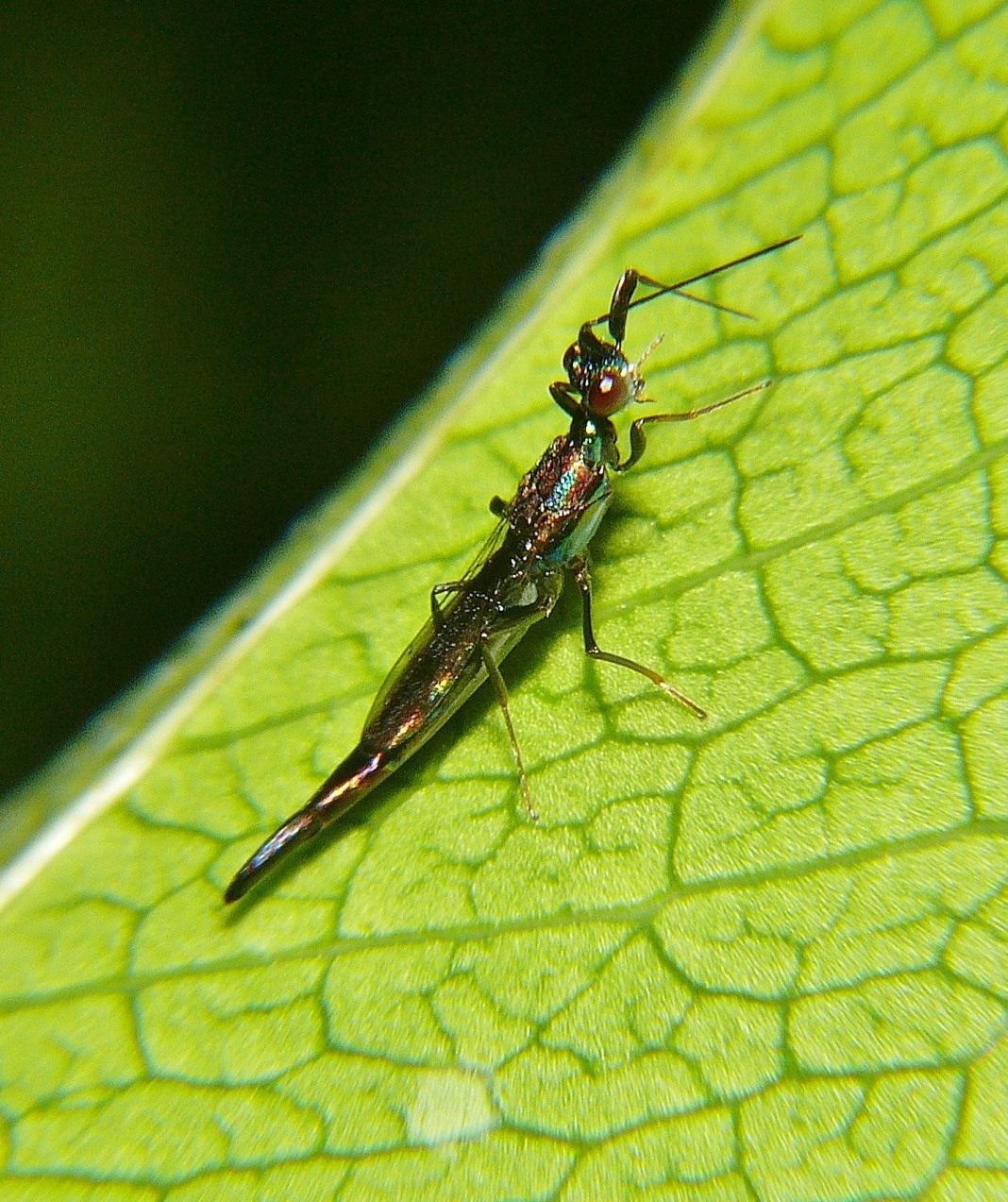
Crucifer bugs. Large insects of bright color in the form of red, yellow, white spots, dashes, stripes on a black background. They mainly damage leaves by sucking plant juices. Leaves change their natural color, turn yellow with marble spots, fade.
Heading stops, it becomes ugly, soft. Young plants die. The greatest harm in the pest development cycle is caused by larvae emerging from eggs. They are wingless form, therefore attached to the plant and, eating on it, destroy the whole plant.
They leave for the winter in mid-August. During the summer period, they can be collected manually, which significantly reduces their numbers and harmfulness.
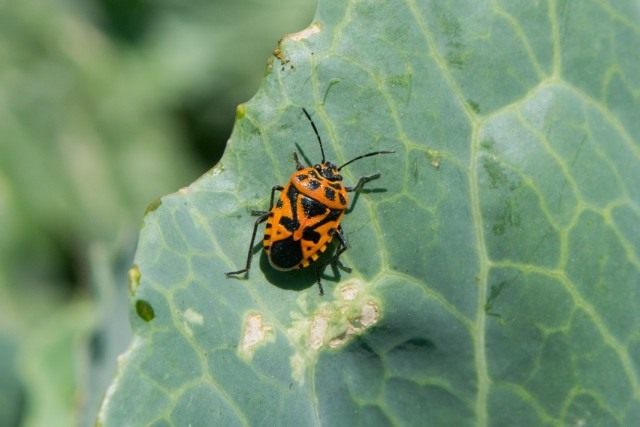
Group of gnawing pests
Of the gnawing pests, cabbage fly, cruciferous fleas, cabbage moth, cabbage scoop and whitewash are the most common. Do not mind to feast on cabbage seedlings flower beetles, mosquitoes-centipedes.
Cabbage fly - a serious pest of cabbage. At the end of May, it lays eggs on the soil near cabbage plants. After 7-8 days, larvae hatch, whose life cycle passes in the roots and lower part of the stem of the culture, where they penetrate from the egg-laying laid in the soil.
Significant damage is caused by the caterpillars of butterflies of the cabbage scoops, moths, and whites. Gnawing holes in the leaves of a head of cabbage and polluting them with their waste, they are able to transfer the entire crop intended for the market to livestock feed.
Cabbage Moth - a small butterfly of gray-brown color. Life expectancy is 30 days. Lays up to 300 eggs in early June (small yellow dots on the underside of the leaf) - in the northern regions, and from April - in the southern ones.
After 3 days, yellowish spindle-shaped, fast cabbage-eater caterpillars appear, intensely feeding on the pulp of leaves around the clock. Over the summer, the pest forms 5-6 generations (every 5-7 weeks a new generation appears).
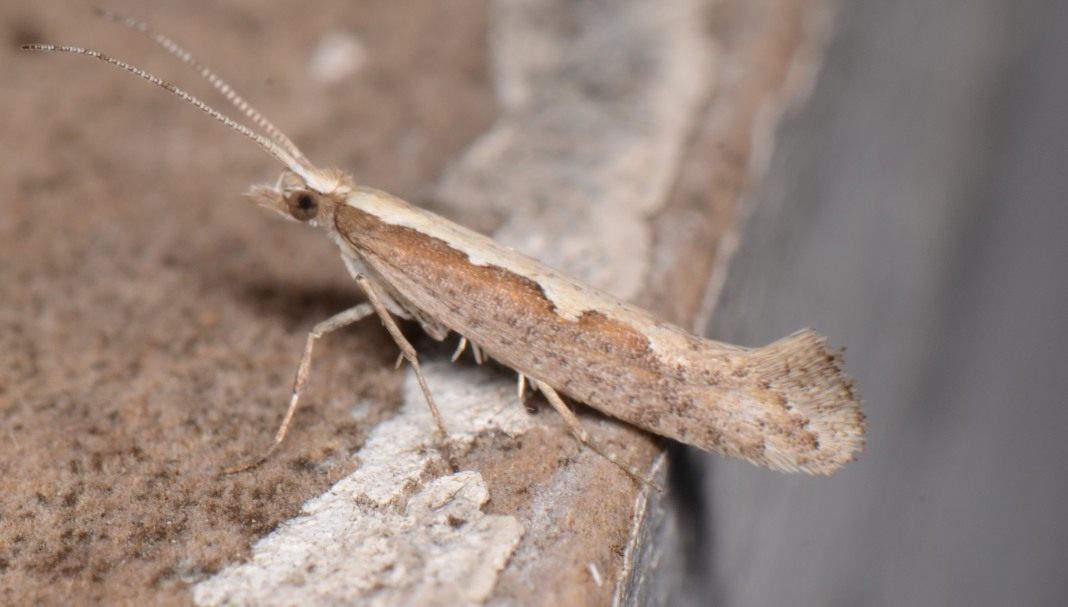
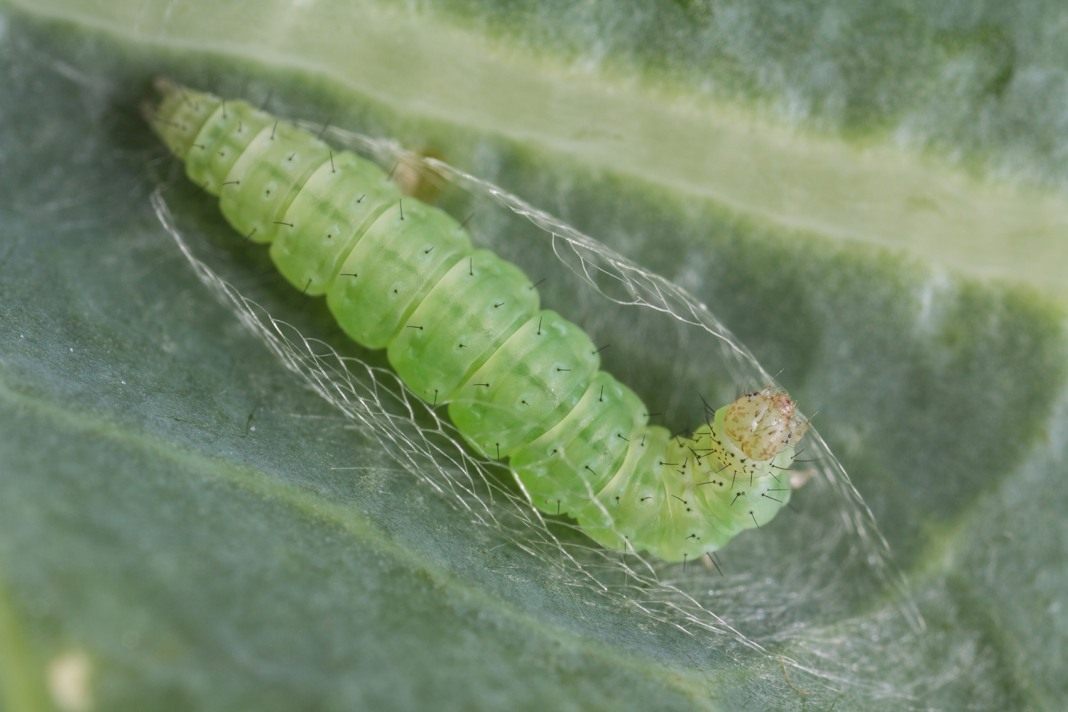
Butterfly White. Favorite butterfly of babies with rapture catching its net. This is a large mole. A distinctive feature is the black round spots on the wings. Lays up to 100 eggs on leaves. The development cycle of caterpillars from eggs is longer than that of a shallow moth. After 8-15 days, caterpillars appear, eating the leaves to the veins.
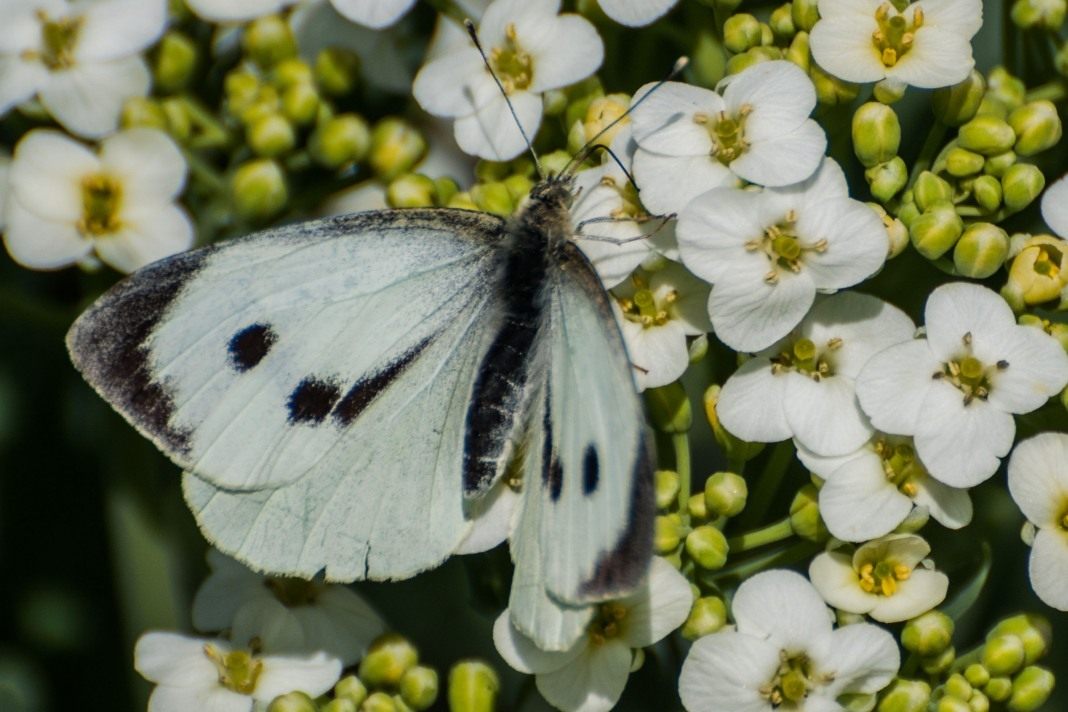
Butterfly scoop. It is especially harmful because it damages about 70 species of plants, including vegetable, fruit, garden flowers, etc. The scoop (baby owl) leads a nocturnal lifestyle. Imperceptible beige-brownish, gray-brown with broken spots of light shades on the wings.
For wintering, they penetrate into the soil up to 10 cm. In the southern regions, it forms 3 generations, in the northern regions - one.
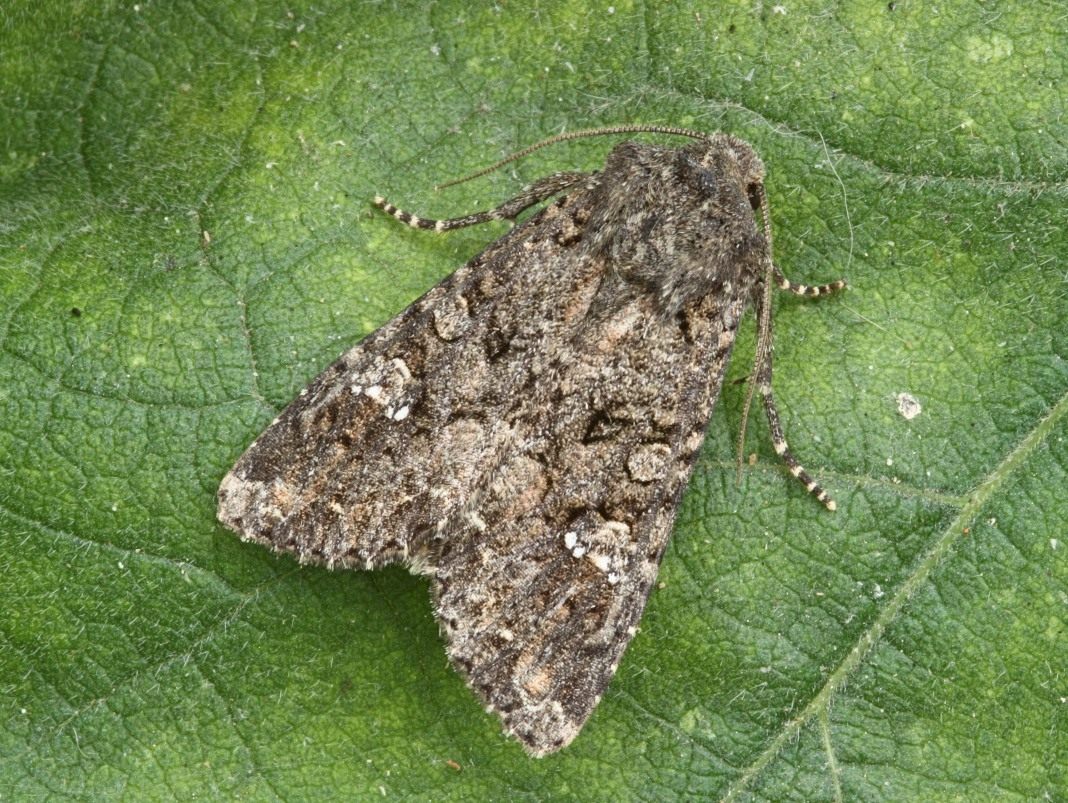
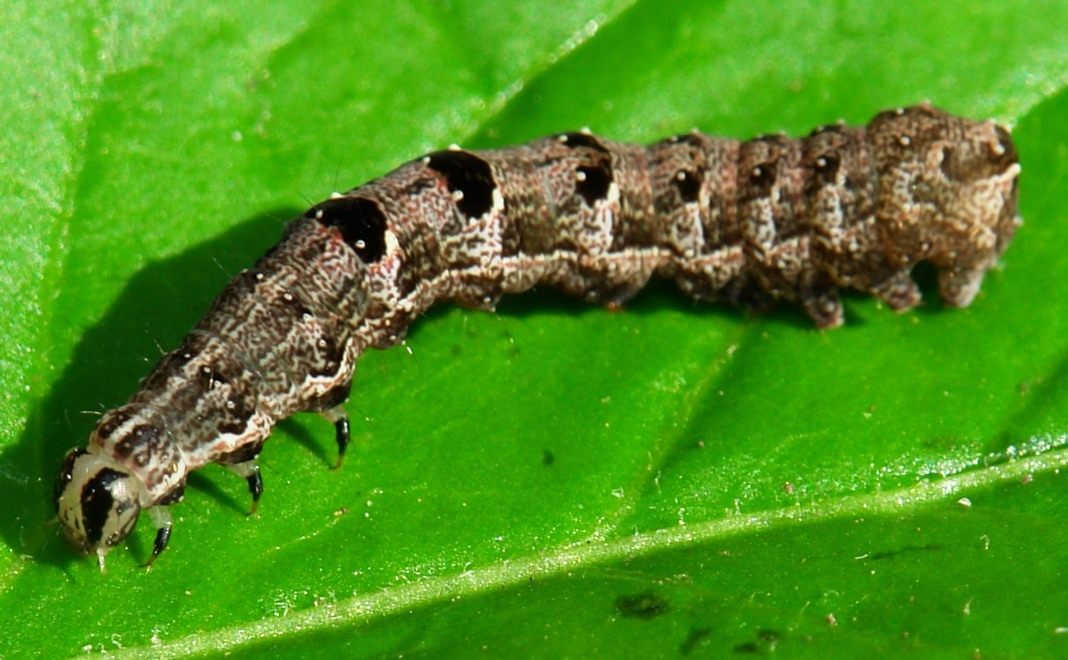
Fleas. Cabbage fleas damage all cruciferous. Small bugs with a characteristic type of movement - jumping, are characterized by increased appetite. If they are not stopped, they are able to completely destroy the seedlings or young seedlings, damaging the young leaves. They hibernate in soil and under various debris, including under plant debris.
The united edges of the leaves are silent witnesses of the night feast. This whole army of pests requires immediate protective measures. The most practical measures are those combining tillage and plants.
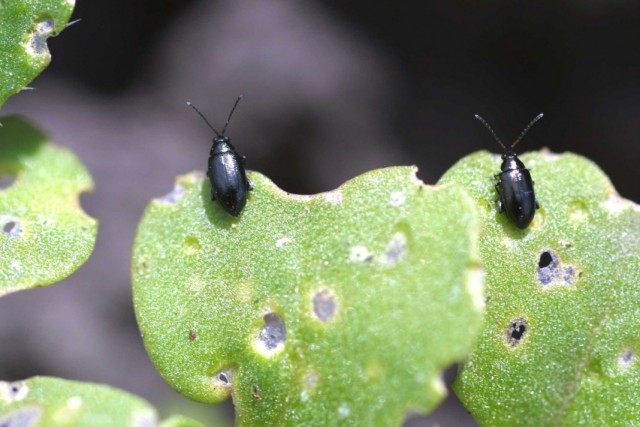
Brief characteristics of the main crop pests clearly indicate the need for systematic processing of plants. 1-2 treatments during the summer period against the background of an untidy plot will not save the plants from damage, the crop will be so poor that it can not be eaten.
Familiarization with the pest development cycles clearly indicates the need for treatments from early spring to harvest.
Their number can be reduced in various ways, the basis of which is compliance with the technology of growing crops. Healthy developed plants better withstand the destructive work of pests.
Agricultural practices
Agricultural practices do not destroy pests of cabbage, but proactive agricultural technology and the precise implementation of technology for growing crops contribute to their significant quantitative reduction and less damage to plants.
- To destroy wintering forms of pests, autumn tillage of the soil and territory is necessary (garbage, weeds, digging the soil, etc.).
- Before transplanting seedlings, it is necessary to destroy the bear, wireworm, and May beetle using one of the methods used in summer cottage conditions.
- Around the site in the spring can not be allowed to bloom forbs. Early-flying butterflies settle on wild plants, and when sprouting or planting seedlings, they move to beds with vegetable crops. The grass is mowed, leaving 4-8 cm of turf that preserves the soil from the negative effects of the environment.
- It is better to propagate insecticides and plants around the site that attract the natural enemies of pests - trichogramma, apantheles, nitobia, and diadromus.
The aphids are destroyed by the larvae of lacewings, beetles and larvae of coccinellids, larvae of surfids, which are considered the main house of weeds.
Thrips (larvae and adults) are happy to eat bugs oriuses and anthocoris, predatory mites, phytoseiids, neoseyulyusy. For breeding on the site, you can buy them in specialized stores or firms.
Chemical protective measures
Cabbage refers to those crops where the use of chemical protective equipment is unacceptable. A tightly curled head of cabbage does not allow to wash off the remnants of the drug, and it gets into the kitchen and further on the menu. Hope for the period of decomposition is impractical. It is not known what the drug itself or its residues is more dangerous.
In April-May (mass seedlings and 3-4 day sprouts of cabbage), you can pollinate plants and soil with dust, naphthalene, dry celandine powder. Or in the same period, plants can be sprayed with solutions of actellica, decis, actara. 20 ml of one of the preparations is diluted in 10 liters of water.
Solutions affect adult insects, so they spray plants and soil. Spend no more than 1-2 sprayings with a period of 3-5 days.
Recently, drugs specifically recommended for cabbage are often recommended: Iskra-M, Fury, Bankol. They can also cultivate the soil and plants. In 3 l of water, add 2 ml of canola and sprinkle the plants and soil. The fleas will disappear. In a later period, it is necessary to switch to other means of protection (biological, folk, physical destruction).
Biological products
Biological products, unlike chemical ones, are based on live fungi, bacteria and nematodes. Their peculiarity is that they do not harm humans and animals. Well combined in tank mixtures.
It is enough for the gardener to have the following biological products in his garden medicine cabinet:
- Bitoxibacillin and Bicol - mainly used against sucking pests and aphids.
- Verticillin - against whiteflies and aphids.
- Nemabakt and Antonem-F - against nematodes, thrips, wireworms, cabbage flies, mining flies, May larvae, larvae, locusts.
- Pecilomycin and metarizine will replace nemabact when protecting against nematodes.
- Actofit will effectively destroy sucking and gnawing pests. One of the best biological products for summer residents. It destroys cabbage moth, aphid, scoop, cabbage whitewash. You can use it not only for processing cabbage, but also for all vegetable crops with one dressing. After 4-16 hours, all pests treated with a biological product die.
Up to 10-12 treatments per season with Actofit and repeated during epidemics after 4-8 days do not have a negative effect on plants. 2 days after processing, the products can be eaten. If Actofit is not on sale, then the biological products Aversectin-S and Avertin-N have similar properties.
All of these drugs are compatible in a tank mixture. If you use a mixture of actophyte with nemabact and bicol, the garden will be cleaned of the main pests of not only cabbage, but also other vegetable crops.
When working with biological products, it is necessary to take into account that their effectiveness reaches its maximum when working in temperature conditions from + 18 ° С. Therefore, in early spring, when temperatures fluctuate between +10 .. + 12 ° С, cabbage plants can be treated with chemicals 1-2 times.
Remember that when preparing the tank mixture, each drug is dissolved separately in accordance with the recommendation, and then the solutions are poured into one container, stirred and sprayed with plants.
It is advisable to check each drug for compatibility with the rest, especially if it is used for the first time. Biological products are easily washed off with water when irrigated by sprinkling and rain, which necessitates frequent processing. But health is more expensive. Only with bioprocessing can you get a full, environmentally friendly product.
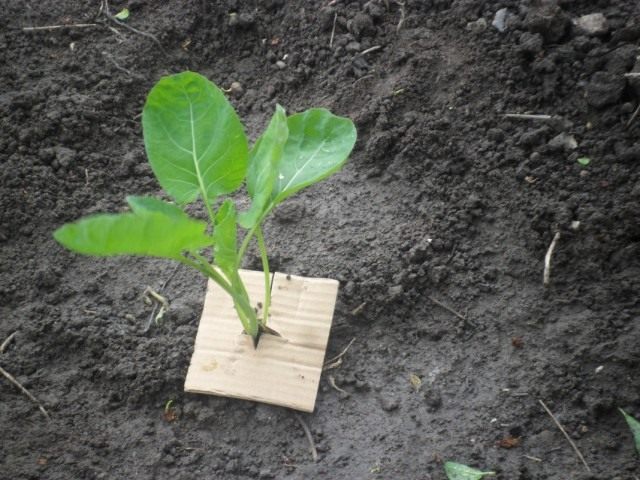
If you began to protect cabbage from pests with biological products, you can not use chemicals. They will cause the death of the living basis of the biological product (fungi, bacteria).
Biological products contain living microorganisms, for which the soil is a natural habitat.
Accumulating in the soil during the processing of plants, some of their species reproduce themselves.The soil is enriched with beneficial microflora, which also protects plants from pests.
Folk pest control
Various sites offer a huge number of decoctions and infusions of insecticide herbs. But their use must be commensurate with their toxicity. For example: plants treated with a hemlock broth can cause poisoning, and the use of aconite decoctions can lead to death.
Be careful and careful. Use only insecticide plants that are familiar to you and always withstand a 2-week period before eating processed fruits and other products.
In order not to use chemicals, young cabbage plants can be pollinated from a flea with tobacco or finely sifted ash mixed with dry mustard before curling a head of cabbage.
From aphids, you can sprinkle young plants with soap and water and wash them off after 24 hours. Caterpillars do not tolerate baking soda. You can sprinkle unfolded cabbage leaves with soda.
Snails and slugs are best collected in crowded places, which should be prepared in advance for them. In the aisles, moisten the soil and cover it with old rags, cardboard, newspapers, moistened with kvass, beer, yeast solution, another sweet and sour drink or just water at night, and collect “drunk” brothers in the morning.
Mustard powder, bitter pepper, tobacco, crushed shells will become an insurmountable obstacle to pests to cabbage, if they are scattered in the aisles.
How to treat cabbage from pests with folk remedies?
Cabbage is one of the few vegetable crops that attracts a small amount of pests. The problem is that they cause irreparable damage to the future crop, up to the complete destruction.
There are three ways to combat various pests:
- Mechanical - the most time-consuming, when malicious individuals are selected manually every 3 days (used only at the initial stage of infection).
- The use of modern insecticides (they can be purchased at specialized gardening stores).
- Folk remedies for the treatment of cabbage from pests.
Since cabbage is grown for eating, it will be wiser to use the latter method. Simple decoctions and infusions will help protect this vegetable from unwanted guests and prevent the death of the crop.
Cruciferous flea. A very small insect of a dark color. She appears on the young shoots of cabbage one of the first. Most often, Beijing cabbage suffers.
Folk methods of struggle:
- Sprinkle the planted seedlings with tobacco dust, dry hot pepper or ash (after each watering or heavy rain, repeat it).
- Fir oil is added to the water for irrigation, the smell of which these insects cannot tolerate (10 drops per bucket of water).
- Treat with non-concentrated solution of bird droppings (insist for a week).
- Watering with flea shampoo (available at any pet store).
- You can prepare the mixture: garlic - 160 g, chopped tomato tops - 110 g, liquid soap - 15 g. Dilute in a 10-liter bucket of water and spray.
- Use vinegar - 250 ml per bucket of water to protect. To water.
Cabbage butterfly (larvae). These are some of the most dangerous pests. Butterflies themselves do not carry any threat to the plant. Caterpillars hatching from their eggs are most harmful. Eating the heads of cabbage from the inside, they cause irreparable damage.
Folk methods of struggle:
- Spray the plants with a decoction of milkweed.
- Apply the solution with the addition of one of these components (when calculating per bucket of water):
- vinegar - 250 ml;
- table salt - 60 g;
- ammonia - 40 g.
- Pour 1 kg of tomato tops with 3 liters of water, cook for 20 minutes, cool, then strain. With this tool, treat those places that are severely affected by pests.
Slugs (snails). The real enemies of the cabbage beds. Protection from them requires the closest attention so as not to lose the entire crop. The main activity is shown in the cool night time. Prefer wet places.
Folk methods of struggle:
- Water the evening with a solution of vinegar - 125 ml or dry mustard - 160 g per bucket of water.
- Carry out a treatment with hot water (50 ° C). Such a procedure can be performed only when the foliage of cabbage has already closed.
- Dig grooves around the beds and fill them with tobacco dust mixed with wood ash.
- Spraying with tincture of hot pepper pods.
Cabbage scoop larvae. At a young age, the caterpillars are green. They cause great harm by gnawing through holes in leaves and heads of cabbage.
Folk methods of struggle. Treat the leaves with the following solution: ash - 2 cups, liquid soap - 20 ml diluted in 10 liters of water. It is possible to use infusions from various herbs: dandelion, celandine, burdock, bitter wormwood.
A broth of hot pepper is sprayed on the soil around the plants. To do this, 50 g of dried pepper or 100 g of fresh boiled in 1 liter of water. After insisting for two days, filter. To obtain a working solution in a bucket of water, dilute 500 ml of broth with the addition of 50 g of any liquid soap.
Cabbage fly. It is quite difficult to fight the larvae of this malicious insect (as well as the cabbage scoop) for the reason that they begin to harm late, when heads of cabbage appear.
It is extremely undesirable to use chemicals during this period, because only 20 to 30 days remain before the harvest. In this case, it will come in handy to treat cabbage from pests with folk remedies.
Folk methods of struggle:
- Use for treatment of heads of cabbage infusion of wormwood, potato or tomato tops (3 kg of dry grass per bucket of water).
- Against this type of caterpillars, a decoction of onion husks works well.
- Pouring the plant with salt water - 250 g of salt in a bucket of water.
- Infected specimens are pollinated with a mixture of ash, black pepper (ground) and tobacco dust, after which they thoroughly loosen the soil around them.
- Burdock infusion can be used as a deterrent. Once a week, cabbage and ground are sprayed with a solution.
Other species of fliesthreatening the crop:
- Onion fly
- Carrot fly
- Aphid cabbage
This dark green (sometimes black) pest up to 2 mm in length infects cabbage seedlings in early spring. It is easy to find it by looking at the bottom of young leaves. He eats their juice during the breeding season.
Use a warm, slightly concentrated solution of laundry soap (grated on a coarse grater).
Pour the beds with a solution of dry mustard: add 30 g of soap (shavings) to 30 g, 300 g of wood ash and tobacco dust.
Infusions of celandine, wormwood, peels of orange, horseradish, and yarrow help. Apply several times per season.
To carry out prophylaxis to protect seedlings or adult specimens is much more effective than treating cabbage from pests with folk remedies or even chemical preparations. The main types of harmful insects are difficult to remove with a strong infection.
Wanting to get an excellent harvest of this delicious vegetable, it is necessary to conduct thorough care, in time to discover "uninvited guests".
How to process cabbage from caterpillars: effective folk remedies
Cabbage is not the easiest vegetable to care for. Especially insects that can appear at the beginning of summer and nullify all your efforts harm her. Most often, cabbage suffers from caterpillars.
If they are found, you must immediately begin to fight pests, otherwise the crop will be irrevocably lost. How to get rid of caterpillars on cabbage this article will tell.
Ways to fight
Cabbage from pests is most often invaded by white cabbage, which is also called cabbage. This pest lays eggs on leaves of cabbage. A few days later, caterpillars hatch from them.
At this stage of their development, they are small, so the damage from their life is not very noticeable. But when their size increases to 4 cm, insects begin to destroy heads of cabbage with great speed.
Caterpillars live 15 to 30 days. After this period, they pupate. Further, butterflies are obtained from the pupae and the cycle repeats again. As a result, if no methods have been taken to combat the scourge, up to three can be formed on your cabbage plantings in the summer, and in all five generations of pests in the southern regions of our country.
If this situation does happen, then the crop is likely to be completely eaten. However, cabbage is not only affected by whitewash. On plants, you can often find replicas. Although its caterpillars are smaller, they have a wonderful appetite.
As we see the question of how to deal with the invasion of caterpillars, it is very relevant for gardeners who are engaged in the cultivation of this crop. You can get rid of butterflies and their offspring in a variety of ways. However, the most effective and efficient method is prevention, which allows you to keep pests at a decent distance from plantings.
It is worth noting that the crop, which was infected with caterpillars, can no longer be eaten. This is due to the fact that it becomes toxic to humans. Therefore, even if you managed to get rid of the misfortune, you will have to throw out the cabbage anyway.
These insects do not like enough spicy and strong odors. This weakness of them can very well be used for the struggle. For example, near plantings, you can plant parsley, celery, sage, cilantro and basil. The rows between cabbage are a great place to plant dill. The smell of these plants is unpleasant for parasites.
At the same time, it is an excellent tool for attracting caterpillars to natural planting enemies (rider beetles, lacewing and ladybug). Therefore, such a simple pest control method as planting spicy crops is considered a very effective preventive solution.
But parasites can also be scared away from planting this vegetable crop by planting feverfew, marigolds, marigold, and nasturtium.
If preventive methods of control were ineffective and insects were able to lay eggs, then there remains only a mechanical way to deal with them. It involves the following manipulations:
- weeding between rows;
- cleaning all plant waste from the beds;
- a thorough inspection of plants for caterpillars or eggs;
- DIY pest collection.
Mechanically, you can collect and destroy the caterpillars of the whitewash and cabbage. At the same time, with the progeny of cabbage moths, due to their mobility, this method of control will be ineffective. In the afternoon this pest is not found at all. Caterpillars sleep, hiding at the base of the stump.
To destroy them, you can use additional assistants. With caterpillars on cabbage, ants and wasps do an excellent job. Therefore, they should be attracted to landings.
There is another quite effective insect control method. A thin transparent net should be pulled over the landings. It must transmit the light necessary for the growth and development of plants.
Such a network will prevent the landing of butterflies on cabbage leaves in order to lay eggs on them. With cabbage sprouts, the mesh will need to be raised.
When using a transparent mesh, it must be understood that it will not protect plantings from pests such as beetles, slugs and aphids. Therefore, some gardeners prefer more radical methods of control, which are based on the use of special drugs.
Indeed, in this case, the processed vegetable has protection against a significantly larger number of parasites.
Caterpillar Remedies
Many gardeners are asking the question "how can you process cabbage" for a more effective fight against insect pests. In specialized stores for this, a wide variety of products are sold:
- tablets;
- powders;
- ampoules.
Any purchased product must simply be diluted in the required amount of water (it is usually recommended to dilute in 10 liters of water). After that, you can process the plants. The prepared solution is often enough to process 50 m2 of landings.
Otherwise, cabbage will become hazardous to human health. For this reason, many gardeners prefer to use folk remedies to combat caterpillars.
Folk techniques
How to treat cabbage from caterpillars with folk solutions? Here you can use a variety of tools. But most often in this situation, the following types of solutions are used:
- vinegar;
- saline;
- from ammonia.
Folk solution for controlling insect pests is prepared as follows:
- take 1 cup of vinegar (can be replaced with 1 tablespoon of vinegar essence), 2 tablespoons of salt or 50 g of ammonia;
- the main component must be diluted in 10 liters of water.
After the remedy is ready, they need to spray each plant. In no case do you need to water the prepared solution with the prepared solution. You can pour cabbage only with water. During the season, this procedure should be carried out several times at a certain time interval.
It is interesting to note that the question “how to treat cabbage with folk remedies for caterpillars” can often be answered with ash. This combustion product has proven itself as an effective parasite repeller. For this, ash is added to the soil, scattering it around the root.
Then the resulting solution should be infused for two days. After that, it is filtered and diluted (150 ml of solution in 10 l of water). And you can also add 40 g of soap. Only after completing these procedures are they sprayed with plantings.
Herbal products can be prepared from the leaves of burdock, chamomile and delphinium, as well as onion husks.
As you can see, there is a lot of way to deal with the caterpillars that appeared on the cabbage. However, the most effective method is the correct prophylactic treatment. Only it allows you to keep your crop safe and sound.
leave a comment